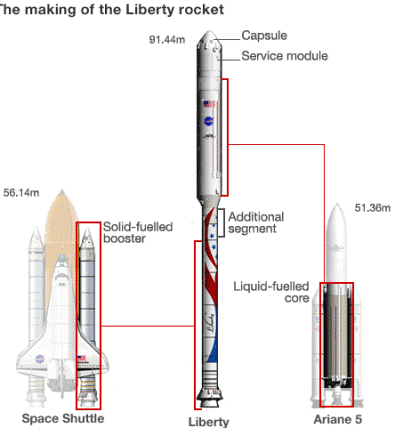After failing to win an award in the latest round of NASA's commercial crew vehicle development grants, ATK's Liberty launch vehicle remains on paper facing an uncertain future.
The Liberty, using a five-segment solid rocket booster developed for the Space Shuttle as a first stage and a Vulcain 2 core stage from the Ariane 5 as an upper stage, was designed to launch 20,000kg (44,000lb) into low Earth orbit.
Though the rocket gained an unfunded space act agreement (SAA) during NASA's second round of commercial crew development grants, Liberty was not selected for funding during the third round, the commercial crew integrated capability (CCiCap).
There is, says Kent Rominger, the Liberty programme manager, "no way on internal funding can we finish the Liberty module, interfaces, design. We probably need on the order of $300 million to get the launcher to [critical design review]. And we're not investing that kind of money."
"So we are on an order of magnitude less than that, keeping the programme alive while finding the right investment structure," Rominger adds.
 |
|---|
©ATK |
ATK and partner Astrium are examining adapting the launch vehicle for satellite launch, which may require large changes to the design, including the addition of third stage, which would introduce a new level of complexity to the rocket.
"Our two stage configuration is really optimized for LEO (low Earth) orbits. It throws phenomenal payload into LEO," says Rominger. "There's not a huge demand for that, satellite-wise. There is some, NASA as well, but GEO (geosynchronous orbit) is where a lot of the business is. In the GEO world we need to bring on a third stage."
Rominger declined to discuss possible third-stage providers.
One major issue with turning to the commercial satellite launch market is the need to price competitively. Flying a human-rated vehicle for NASA allows ATK to charge relatively high prices, while the international market for satellite launches is much more competitive.
Flights for NASA would allow ATK to profit from a single launch per year, whereas the launch rate for satellites must be significantly greater. In terms of annual commercial launches, "with four we're healthy. We'd do a lot better at six," says Rominger.
Source: Flight International


























